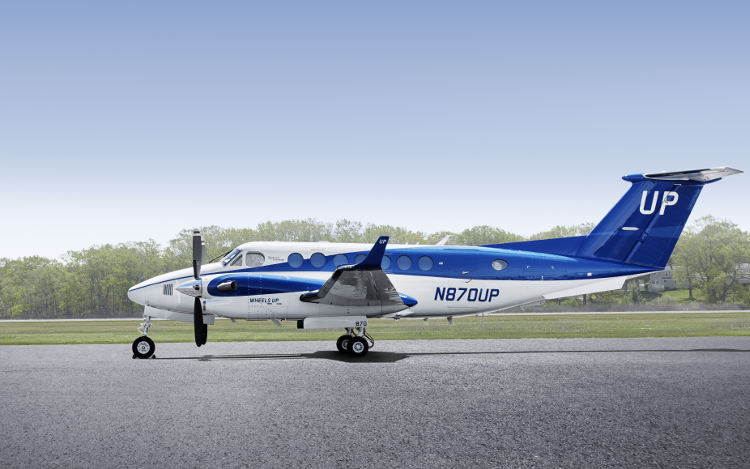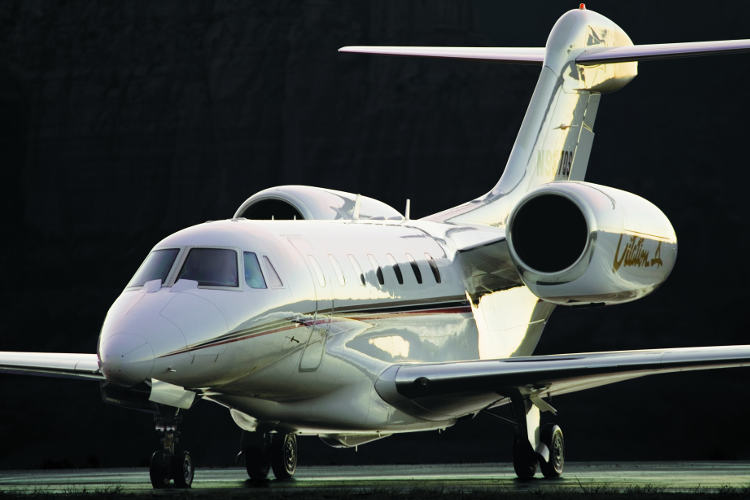With dozens of private aircraft service and jet card companies now vying for your business, it’s challenging to choose between the many types of pricing, services, and value-added bonuses. Here we break down the differences between venerable NetJets and newcomer Wheels Up.
History & Background
NetJets, founded by three retired military pilots in 1964 as Executive Jet Aviation, is the granddaddy of fractional ownership and private jets. Since its inception, it has grown from a fleet of ten Learjet 23 aircraft to 10 types of planes and over 900 aircraft worldwide—the world’s largest private jet fleet.
Richard Santulli, a mathematician and former executive with Goldman Sachs, purchased the company in 1984. After poring over 22 years’ worth of pilot logbooks, he crafted an innovative new model of fractional aircraft ownership. NetJets was renamed in 1984 and acquired by Warren Buffet, a NetJets share owner, in 1998, who added it to the Berkshire Hathaway umbrella. NetJets subsequently acquired the Marquis Jet Card program in 2010.
The younger Wheels Up has homed in on reducing the up-front costs of private flying and offering a value-added experience. The company was created by businessmen Bill Allard and Kenny Dichter, the “Kevin Bacon of entrepreneurship,” and offers a mobile app that allows members to manage their accounts, book flights, look for ride-share opportunities and private shuttle flights at a reduced cost, and find discounted one-way fare on empty-leg flights.
Wheels Up operates a fleet of 330 owned and managed aircraft, and provides access to a further 1,200 aircraft in all private aircraft cabin classes through a network of safety vetted and verified third-party operators. Wheels Up’s specialty program, Wheels Down, connects members to exclusive events and experiences, a luxury concierge service, and additional benefits that it says are valued at up $25,000. Wheels Up went public in 2021, and trades on the NYSE under the symbol "UP". .

Aircraft
If you fly on the Wheels Up or NetJets owned fleets, your plane will always be fitted out in a standard configuration, with the latest equipment and technology.
NetJets offers four sizes of aircraft:
Light Cabin
Known for their speed and ability to land on the shortest runways and at the smallest, most remote airports, NetJets’ Light Cabin aircraft are available with as little as four hours’ notice.
- Embraer Phenom 300—up to 6 passengers; 74 cubic feet baggage capacity; 3,196 km range. One of NetJets’ most requested aircraft, thanks to its comfortable interior.
Midsize Cabin
NetJets’ midsize-cabin aircraft offer additional space for work and comfort, and are capable of flying longer distances.
- Cessna Citation XLS—up to 7 passengers; 79 cubic feet baggage capacity; 3,441 km range. Offers the amenities of a midsize-cabin jet with the ability to fly into and out of smaller airports.
- Cessna Citation Latitude—up to 7 passengers; 100 cubic feet baggage capacity; 4,937 km range. This midsize jet measures 6 feet in cabin height and has the largest cross-section in NetJets’ midsize class.
- Cessna Citation Sovereign—up to 8 passengers; 100 cubic feet baggage capacity; 5,219 km range. Able to fly longer ranges in high elevations.
Super-Midsize Cabin
Extended ranges, speed, larger passenger capacity, and flexible seating configurations make these jets the top choice for transcontinental business travel.
- Cessna Citation Longtitude—up to 8 passengers; 112 cubic feet baggage capacity; 5,600 km range. This aircraft is reputed to have one of the quietest cabins.
- Bombardier Challenger 350—up to 9 passengers; 106 cubic feet baggage capacity; 6,047 km range. One of the longest flying ranges of all private jets.
Large Cabin
The top choice for global flyers, these aircraft—staffed by a NetJets flight attendant—can transport up to 14 passengers for up to 14 hours. Large Cabin aircraft flights also feature luxury food service.
- Dassault Falcon 2000/2000EX—up to 10 passengers; 134 cubic feet baggage capacity; 5,429 km range. This aircraft mixes business with pleasure, offering flexible conference and club seating and a comfortable large-cabin feel.
- Bombardier Challenger 650—up to 11 passengers; 115 cubic feet baggage capacity; 6,833 km range. Considered a world-class large-cabin jet, the Challenger 650 provides optimal comfort and mobility during coast-to-coast and even intercontinental flights.
- Bombardier Global 5500—up to 13 passengers; 195 cubic feet baggage capacity; 10,400 km range. Designed for premium comfort, this large-cabin aircraft is a popular choice for transatlantic trips.
- Bombardier Global 6000—up to 13 passengers; 195 cubic feet baggage capacity; 11,600 km range. Known for its transpacific performance, this speedy jet has long range.
- Bombardier Global 7500—up to 14 passengers; 195 cubic feet baggage capacity; 12,000 km range. The flagship, offers a four zone cabin.
The Wheels Up fleet is more streamlined, featuring three main types of aircraft, plus a variety of others across all cabin sizes:
- King Air 350i—up to 8 passengers; 71 cubic feet baggage capacity; 3,345 km range. This twin-turboprop aircraft, part of a line that’s been in continuous production since 1974, is built for short to medium distances.
- Cessna Citation Excel/XLS—up to 7 passengers; 79 cubic feet baggage capacity; 3,441 km range. Offers the amenities of a midsize-cabin jet with the ability to fly into and out of smaller airports.
- Cessna Citation X—up to 8 passengers; 82 cubic feet baggage capacity; 5,300 km range. One of the fastest civilian jets ever made.

Availability
For NetJets fractional owners, 4 to 6 hours’ notice is required, and there are 15 peak period days (with 48 hours’ notice required during peak periods).
The company also offers two jet card programs, its original NetJets Jet Card and a newer Elite Jet Card. For Netjets Jet Cards, 48 hours’ notice is required for booking, and there are currently 45 peak days (with 120 hours’ notice required during peak) and 45 no fly days. FET is excluded from the overall price, and flights are subject to a fuel surcharge.
Elite Jet Cards are offered in 25-hour blocks on its two Citation light jets. Minimum booking notice is 48 hours, and there are 45 peak days per year and no fly days, also with 120-hour minimum booking notice. It’s important to note that a 25% premium is assessed for hours on peak days, unlike with the NetJets card, where you’re charged for actual flight time only. Elite pricing includes FET and fuel.
For all three NetJets programs, downgrades are guaranteed, and upgrades are subject to availability, within 24 hours of making a request. Card program members can also expect extra fees for international travel, ground transportation, and other miscellaneous charges.
Wheels Up gives members access—with guaranteed availability 300 days a year for individuals and 315 days a year for businesses—to its entire fleet with as little as 24-hour notice. For their prepaid programs, both hours-based and fund deposit–based, as you purchase more, three changes occur:
- The number of guaranteed availability days increases
- The number of peak days decreases
- The amount of time required for advanced booking decreases
Wheels Up also provides a flight desk for expert help in locating a larger aircraft or for when their own aircraft are not available.
Hours, Memberships, and Pricing
A NetJets fractional membership gives you an ownership interest in a chosen aircraft. Prices vary according to the type of jet and flight frequency, with the minimum available fractional share offering a 1/16 interest and 50 hours’ of flight time. There’s a one-time acquisition cost, plus a monthly management fee and an occupied hourly fee for fuel, maintenance, catering, and landing. After the minimum term, NetJets offers a guaranteed buy-back option if you opt out of the program.
NetJets Jet Cards are made for people who fly fewer than 50 hours per year. Prepay for flight time on the aircraft of your choice, and you have access to it for 25 hours at a time over 24 months, with the flight time deducted from your card balance. Pricing starts in the neighborhood of $200,000.
Wheels Up operates on a pay-as-you-fly model with no minimum hourly commitment. Individuals pay an initiation fee of $17,500 for Core membership ($29,500 for businesses), with annual dues in year two and beyond priced at $8,500 for Core ($14,500 for businesses). Members pay a capped fixed hourly rate only for occupied flights: $5,395 on the King Air and $6,995 on light jets. Wheels Up also offers Connect membership for $2,995 per year.
Wheels Up also offers a pre-purchase block, available in increments of $100,000, $200,000, and $400,000, which unlocks access to additional guarantees, fewer peak days, and other benefits; the cost of each flight is deducted from the block.
Terms
NetJets’ fractional ownership has a minimum term of 36 months, while its Jet Cards are good for 24-months. Wheels Up has an annual renewable membership.
NetJets and Wheels Up both offer a range of compelling options for luxury personal and business travel. The type of ownership, membership or card program you choose will depend on a variety of factors including how often you need to fly, how many amenities you prefer to have, how much notice you’re able to give, and which aircraft type is most suitable.
If you are actively comparing NetJets and Wheels Up, or looking at other leading providers, then subscribe to our members only comparisons. This gives you access to side by side, detailed comparisons of the key features for the leading fractional providers, and jet card and membership companies in North America.

